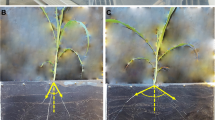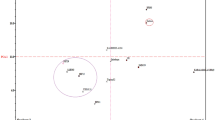Abstract
Response to drought of sugarcane for root traits is considered to be an important mechanism in which the crop can maintain cane yield under drought conditions. The objective of this study was, therefore, to investigate root distribution patterns of sugarcane and their relationships with cane yields under rain-fed conditions. Thirteen elite sugarcane clones (KK06-501, KK07-478, NSUT08-22-3-13, RT2004-085, CSB06-2-15, CSB06-2-21, CSB06-4-162, CSB06-5-20, TBy27-1385, TBy28-0348, MPT02-458, MPT03-166 and 91-2-527) and three check varieties (KK3, LK92-11 and Kps01-12) were planted in a randomized complete block design with four replications at two locations. Root length density (RLD) was measured via the auger method at 4, 6 and 8 months after planting (MAP) at two positions between plants and between rows. Cane yield was measured at 12 MAP. RLD in the upper soil layers was measured at 0–20 cm and 20–40 cm below the soil surface, whereas RLD in the lower soil layers was measured at 40–60, 60–80 and 80–100 cm below the soil surface. Sugarcane genotypes were significantly different for RLD and cane yield in both locations, and the RLDs of the 13 sugarcane varieties grown under rain-fed conditions were classified into four patterns. The sugarcane varieties changed their root distribution patterns when evaluated at 6 and 8 MAP. KK3 was predominant and most interesting as it had consistently high yield in both locations and high root length density in the lower soil layers in response to drought.









Similar content being viewed by others
Abbreviations
- DAP:
-
Days after planting
- LSD:
-
Least significant difference
- MAP:
-
Months after planting
- RLD:
-
Root length density
References
Araki, H., S. Morita, J. Tatsumi, and M. Iijima. 2002. Physio-morphological analysis on axile root growth in upland rice. Plant Production Science 5: 286–293.
FAO. 2016. Production. Accessed March 3, 2018. http://www.fao.org/faostat/en/#data/QC/visualize.
Ford, K.E., P.J. Gregory, M.J. Gooding, and S. Pepler. 2006. Genotype and fungicide effects on late-season root growth of winter wheat. Plant and Soil 284: 33–44.
Gesimba, R.M., E. Njoka, and M. Kinyua. 2004. Root characteristics of drought tolerant bread wheat (Triticum aestivum) genotypes at seedling stage. Asian Journal of Plant Sciences 3: 512–515.
Gomez, K.A., and A.A. Gomez. 1984. Statistical procedures for agricultural research, 2nd ed. New York: Wiley.
Inman-Bamber, N.G., C. Baillie, J. Willcox, S. Attard, and M.F. Spillman. 2003. Increased profitability and water use efficiency through best use of limited water under supplementary irrigation in sugarcane. Final Report for Rural Water Use Efficiency Initiative, Queensland Department of Natural Resources and Mines. CSIRO Sustainable Ecosystems, Townsville.
Inman-Bamber, N.G., P. Lakshmanan, and S. Park. 2012. Sugarcane for water-limited environments: Theoretical assessment of suitable traits. Field Crops Research 134: 95–104.
Jangpromma, N., S. Thammasirirak, P. Jaisil, and P. Songsri. 2012. Effects of drought and recovery from drought stress on above ground and root growth, and water use efficiency in sugarcane (Saccharumofficinarum L.). Australian Journal of Crop Science 6(8): 1298–1304.
Jongrungklang, N., B. Toomsan, N. Vorasoot, S. Jogloy, K.J. Boote, G.T. Hoogenboom, and A. Patanothai. 2011. Rooting traits of peanut genotypes with different yield responses to pre-flowering drought stress. Field Crops Research 120: 262–270.
Jongrungklanga, N., B. Toomsana, N. Vorasoota, S. Jogloya, K.J. Booteb, G. Hoogenboomc, and A. Patanothaia. 2013. Drought tolerance mechanisms for yield responses to pre-flowering drought stress of peanut genotypes with different drought tolerant levels. Field Crops Research 144: 34–42.
Khonghintaisong, J., P. Songsri, B. Toomsan, and N. Jongrungklang. 2017. Rooting and physiological trait responses to early drought stress of sugarcane cultivars. Sugar Tech 20(4): 396–406.
Laclau, P.B., and J.P. Laclau. 2009. Growth of the whole root system for a plant crop of sugarcane under rain-fed and irrigated environments in Brazil. Field Crops Research 114: 351–360.
Office of the Cane and Sugar Board. 2015. Sugarcane cultivars in Thailand. Khon Kean: Khon Kean prints Ltd.
Ohashi, A.Y.P., R.C. de Matos Pires, R.V. Ribeiro, and A.L.B. de Oliveira Silva. 2014. Root growth and distribution in sugarcane cultivars fertigated by a subsurface drip system. Bragantia 74(2): 131–138.
Robertson, M.J., N.G. Inman-Bamber, R.C. Mochow, and A.W. Wood. 1999. Physiology and productivity of sugarcane with early and mid-season water deficit. Field Crops Research 64: 211–227.
Serraj, R., L. Krishnamurthy, J. Kashiwagi, J. Kumar, S. Chandra, and J.H. Crouch. 2004. Variation in root traits of chickpea (Cicer arietinum L.) grown under terminal drought. Field Crops Research 88: 115–127.
Smith, D.M., N.G. Inman-Bamber, and P.J. Thorburn. 2005. Growth and function of the sugarcane root system. Field Crops Research 92: 169–183.
Songsri, P., S. Jogloy, N. Vorasoot, C. Akkasaeng, A. Patanothai, and C.C. Holbrook. 2008. Root distribution of drought-resistant peanut genotypes in response to drought. Journal of Agronomy and Crop Science 19: 92–103.
Uga, Y., Y. Kitomi, S. Ishikawa, and M. Yano. 2015. Genetic improvement for root growth angle to enhance crop production. Breeding Science 65(2): 111–119.
Uga, Y., K. Sugimoto, S. Ogawa, J. Rane, M. Ishitani, N. Hara, Y. Kitomi, Y. Inukai, K. Ono, and N. Kanno. 2013. Control of root system architecture by deeper rooting increases rice yield under drought conditions. Nature Genetics 45: 1097–1102.
Wang, H., J. Siopongco, L.J. Wade, and A. Yamauchi. 2009. Fractal analysis on root systems of rice plants in response to drought stress. Environmental and Experimental Botany 65: 338–344.
Welbank, P.J., M.J. Gibb, P.J. Taylor, and E.D. Williams. 1974. Root growth of cereal crops In: Rothamsted experimental station annual report 1973, Part 2, 26–66. Harpenden, UK: Rothamsted Experimental Station.
Xiong, L., R.G. Wang, G. Mao, and J.M. Koczan. 2006. Identification of drought tolerance determinants by genetic analysis of root response to drought stress and abscisic acid. Plant Physiology 142: 1065–1074.
Acknowledgements
The research project was funded by the Northeast Thailand Cane and Sugar Research Center (NECS), Faculty of Agriculture, Khon Kaen University, the National Science and Technology Development Agency (NSTDA) and the Thailand Research Fund (TRF), Thailand. We also wish to extend our thanks to the manuscript preparation project under Faculty of Agriculture, KKU and TRF, Thailand.
Author information
Authors and Affiliations
Contributions
Sawettachat Set-tow carried out the whole experiment and made manuscript draft and was responsible for the main experimental assignments, data analysis and manuscript preparation; P. Songsri guided in working concepts and advised in physiological and rooting tirats; N. Jongrungklang guided in working concepts.
Corresponding author
Ethics declarations
Conflict of interest
The authors declare that they have no conflict of interest.
Additional information
Publisher's Note
Springer Nature remains neutral with regard to jurisdictional claims in published maps and institutional affiliations.
Rights and permissions
About this article
Cite this article
Set-Tow, S., Songsri, P. & Jongrungklang, N. Variations in Root Distribution Patterns and Cane Yield of 16 Elite Sugarcane Clones Grown Under Varied Soil Conditions. Sugar Tech 22, 1018–1031 (2020). https://doi.org/10.1007/s12355-020-00834-x
Received:
Accepted:
Published:
Issue Date:
DOI: https://doi.org/10.1007/s12355-020-00834-x




